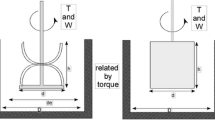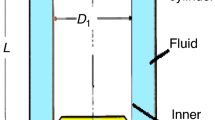Abstract
In this study, we have investigated the possibility of using the Marsh cone as a viscometer. Rheological measurements along with digital image recording of Marsh cone flow on glycerol-water mixes were carried out. The equations needed to solve the flow problem are written in the case of a purely Newtonian viscous fluid. We show that flow time can be directly linked to the Newtonian viscosity. Flow time is proportional to viscosity. The Marsh cone is then used to test several cement pastes and measured flow time is compared to predicted flow time. The correlation between flow time and cement pastes apparent viscosity stays valid only for no yield stress cement pastes and for flow time higher than about 15 s.
Résumé
Dans cette étude, on a évalué la possibilité d'utiliser le cône de Marsh en tant que viscosimètre. Des mesures rhéologiques, couplées avec des enregistrements d'images numériques d'écoulements au cône de Marsh, de mélanges de glycérol et d'eau ont été effectués. Les équations nécessaires pour résoudre le problème ont été écrites dans le cas d'un fluide purement visqueux. On montre alors que le temps d'écoulement est proportionnel à la viscosité. Le cône de Marsh est ensuite essayé sur des p⋲tes de ciment pour lesquelles le temps d'écoulement mesuré est comparé à celui calculé. La corrélation entre le temps d'écoulement et la viscosité apparente reste valide uniquement pour les pâtes de ciment n'ayant pas de seuil d'écoulement et pour des temps d'écoulement supérieurs à environ 15 s.
Similar content being viewed by others
References
Aïtcin, P.C. and Baalbaki, M., ‘Concrete admixtures—Key components of modern concrete, Concrete technology: New trends, Industrial Applications’, (E&FN Spon, London, 1994) 33–47.
De Larrard, F., Bosc, F., Catherine, C. and Deflorenne, F., ‘The AFREM method for the mix-design of high performance concrete’,Mater. Struct. 30 (201) (1997) 439–446.
Agullo, L., Toralles-Carbonari, B., Gettu, R. and Aguado, A., ‘Fluidity of cement pastes with mineral admixtures and superplasticizer—A study based on the Marsh cone test’,Mater. Struct. 32 (221) (1999) 479–485.
EN 445, ‘Grout for prestressing tendons—tests methods’ (1996).
ASTM C939-94a, ‘Standard test method of flow of group for preplaced-aggregate concrete (flow cone method)’ 470–471.
EN 12 715, ‘Execution of special geotechnical work—grouting’ (2000).
Nehdi, M., Mindess, S. and Aïtcin, P.C., ‘Statistical modelling of the microfiller effect on the rheology of composite cement pastes’,Adv. in Cem. Res. 9 (33) (1997) 37–46.
Cordin, J., ‘SCC segregation: mix fitting parameters influence on SSC cement paste fresh behaviour’, Internal report LCPC, France, (2002) [only available in French].
Author information
Authors and Affiliations
Additional information
Editorial Note LCPC is a RILEM Titular Member.
Rights and permissions
About this article
Cite this article
Le Roy, R., Roussel, N. The marsh cone as a viscometer: Theoretical analysis and practical limits. Mat. Struct. 38, 25–30 (2005). https://doi.org/10.1007/BF02480571
Received:
Accepted:
Issue Date:
DOI: https://doi.org/10.1007/BF02480571




